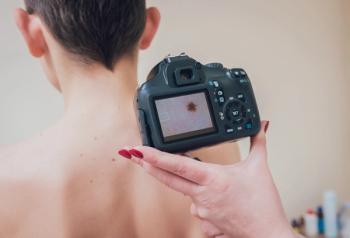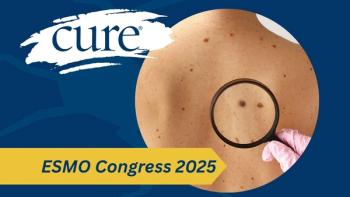
New, Unusual or Changing: How to Detect Skin Cancer

Transcript:
Kristie L. Kahl: Why is early detection so key in skin cancer?
Jeremy Brauer: Early detection is so key because these skin cancers have a very high cure rate when identified and treated early. If these are caught in the earliest of stages and removed and treated appropriately at early stages, the cure rates can approach 99%.
Kristie L. Kahl: How often should people be visiting a dermatologist?
Jeremy Brauer: I like to tell individuals you should feel more than comfortable to see a dermatologist as often as you feel is necessary. Specifically, for total body skin examinations, everyone after a certain age should have an annual skin check, where the dermatologist has the opportunity to evaluate your skin from head to toe, front to back. That should be in conjunction with the monthly self-exam, which you would perform by yourself and/or with someone at home that can help you, usually with a handheld mirror, a blow dryer and a full-length mirror. That helps you to get a full look at your body to try to identify anything new, changing or unusual.
Once you have a diagnosis of skin cancer, in particular non-melanoma skin cancer, I like to have individuals come back for at least twice or a bi-annual skin check. With patients with melanoma, on the initial diagnosis in the beginning, I prefer to bring them in every three to four months a year, and then we transition over to twice a year.
One caveat to that, if there are individuals with a large number of nevi, or moles, or funny-looking lesions on the skin, or there is a strong family history for melanoma, that may also cause a dermatologist to increase the frequency from a once-a-year skin check to twice a year.
Kristie L. Kahl: What are some of the warning signs associated with the different types of skin cancer?
Jeremy Brauer: There are different types of skin cancer — basal cell carcinoma, squamous cell carcinoma, melanoma – and they do, in general, have different appearances, but the more general response is that anything on the skin that is new, unusual or changing warrants bringing it to the attention of your dermatologist.
In general, basal cell carcinomas, looking for pink or translucent bumps on the skin; they can be skin-colored or speckled. You can actually have what is called pigmented-cell carcinomas. These are generalities and these can take any shape, size or form for all skin cancers, which is why it is important to identify something that doesn’t seem right — that E in the ABCDE’s.
With squamous cell carcinoma, we tend to describe these as red and scaly or rough. They can be raised; they can be warty.
A good number of melanomas will be what we call de novo, they are going to rise independent of an existing mole. However, a change in an existing mole, so your ABC’s — it’s asymmetric, the borders are irregular, the color has changed, there is a large diameter, and the evolution of that lesion. To be fair, there are melanomas that are what we call amelanotic melanomas that have no pigment at all and may looks like a basal or squamous cell carcinoma, where it is a pink blemish on the skin.
Additionally, lesions that are bleeding, or ulcerating, so it’s a sore and not healing. A very common story is a non-healing pimple. If someone has a pimple on their nose, they’ve treated as though it were a pimple or acne, and it persists for weeks to months at a time, that is something you should bring to the attention of your dermatologist and perhaps have it biopsied.
Kristie L. Kahl: What exactly can be new, changing or unusual that people should be looking out for?
Jeremy Brauer: Most people will and can develop new moles into their 30s, and in some cases their 40s, but it’s less common. At that point, when you are in your 30s and 40s and you start to get new lesions, take that very seriously. You should always take development of new lesions seriously if they are unusual to you in any way or they are changing in any way. The good news is that, as your life goes on, will get new spots on your skin and most of the time those will be benign. And please, we’d much prefer you go into your dermatologist and let us evaluate the lesion and tell you don’t worry about it, than to neglect it. If you identify, detect and intervene early, these things have a very high cure rate.
Kristie L. Kahl: What does a thorough self-exam consist of?
Jeremy Brauer: A thorough self-examination consists of really taking that time once a month, sitting in front of a full-length mirror or taking a handheld mirror, and if you have a hair dryer or blower, those are the only tools you need in addition to your own eyes. If you have the benefit of a second pair of eyes, either a loved one or significant other or someone you’re comfortable helping to examine you.
It’s then taking a look from top to bottom. Use the hair blower to look through your scalp. Look in front and behind your ears. Look at the tip of your nose, your fingertips, your palms, your soles. Look at the genitalia. Really look everywhere you have skin because the truth of the matter is: Where there is skin, you can develop skin cancer. Yes, 90% of skin cancer will occur because of the sun and will occur on those exposed areas. However, there are absolutely areas where you can develop melanoma or other skin cancers where, as we say, “the sun don’t shine.”
Specifically, for men and woman, you should look everywhere on the body, but melanoma tends to be on the legs of women and on the back of men. So, backs of legs or the back are not areas easily seen by an individual, so all the more reason to have that second mirror or second individual help you during those exams.
Kristie L. Kahl: The Skin Cancer Foundation has a campaign called the Big See, can you talk about this?
Jeremy Brauer: The Big See is a fantastic campaign. It was launched last year. It’s multimodal — there are television commercials, it’s on the internet, print media. It goes back to what we’ve been talking about. We can speak hours on the characteristics of what certain skin cancers look like and how best to detect them. But the truth is that we should simplify the message to help individuals understand what warrants the alarm bells going off and what warrants you making the phone call to visit a dermatologist.
It’s three simple things: something that is new, unusual or changing. That is really the primary message. Any of those, one or more, that describes a skin lesion you have, pick up the phone and make that appointment.
Transcription edited for clarity.





